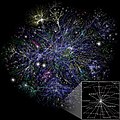The Barabási–Albert (BA) model is an algorithm for generating random scale-free networks using a preferential attachment mechanism. Several natural and...
21 KB (2,744 words) - 03:34, 4 June 2025
Bianconi–Barabási model is named after its inventors Ginestra Bianconi and Albert-László Barabási. This model is a variant of the Barabási–Albert model. The...
22 KB (3,121 words) - 19:54, 12 October 2024
Harvard University. In 1999 Barabási discovered the concept of scale-free networks and proposed the Barabási–Albert model, which explains the widespread...
40 KB (4,111 words) - 13:58, 29 March 2025
Scale-free network (redirect from Generalized scale-free model)
PMID 11005838. Barabási, Albert-László (2004). Linked: How Everything is Connected to Everything Else. Perseus Pub. ISBN 0-452-28439-2. Barabási, Albert-László;...
47 KB (6,015 words) - 00:15, 6 June 2025
preferential attachment family of models, such as the Barabási–Albert (BA) model. (On the other hand, the Barabási–Albert model fails to produce the high levels...
11 KB (1,613 words) - 14:01, 15 May 2025
University of Notre Dame in 2001. Albert is co-creator, together with Albert-László Barabási, of the Barabási–Albert model for generating scale-free random...
8 KB (666 words) - 20:56, 27 May 2025
social networks. Some modeling alternatives include Barabási–Albert model and Watts and Strogatz model. These alternative models are not percolation processes...
19 KB (2,795 words) - 05:56, 9 April 2025
in effect, makes the Watts–Strogatz model a random network. The Barabási–Albert model is a random network model used to demonstrate a preferential attachment...
69 KB (9,906 words) - 21:46, 25 May 2025
Node deletion (section Barabási-Albert model)
so the diameter goes up. Barabási, A.-L. NETWORK SCIENCE, Cambridge University Press 2015 Albert, R.; Jeong, H.; Barabási, A.L. Error and attack tolerance...
5 KB (766 words) - 12:14, 6 November 2023
hierarchical models nodes with more links are expected to have a lower clustering coefficient. Moreover, while the Barabási-Albert model predicts a decreasing...
9 KB (1,192 words) - 03:30, 26 March 2024
Bianconi and Albert-László Barabási proposed a new model called Bianconi-Barabási model, a variant to the Barabási-Albert model (BA model), where the probability...
6 KB (863 words) - 15:34, 13 November 2023
random networks. Scale-free networks (Barabási–Albert model) are different from random networks (Erdős–Rényi model) in two aspects: (a) growth, (b) preferential...
11 KB (1,450 words) - 16:04, 5 January 2025
more recent Barabási–Albert model is that the Price model produces a graph with directed edges while the Barabási–Albert model is the same model but with...
9 KB (1,565 words) - 14:21, 14 April 2025
hypercubes. Some models of growing networks that produce scale-invariant degree distributions are the Barabási–Albert model and the fitness model. In a network...
19 KB (2,448 words) - 15:52, 5 January 2025
attractiveness is a possible extension of the Barabási–Albert model (preferential attachment model). The Barabási–Albert model generates scale-free networks where...
7 KB (1,002 words) - 19:56, 12 October 2024
widely known generative models for scale-free networks are stochastic, such as the Barabási–Albert model or the Fitness model can reproduce many properties...
5 KB (819 words) - 22:43, 17 March 2025
phenomena in economics. In their first model, known as the Barabási–Albert model, Barabási and Albert (BA model) choose Π ( i ) = k i ∑ j = 1 k j {\displaystyle...
13 KB (1,917 words) - 18:52, 28 May 2025
networks, the uniform-preferential-attachment model, or UPA model is a variation of the Barabási–Albert model in which the preferential attachment is perceived...
5 KB (1,044 words) - 13:27, 3 March 2024
0024926. PMC 3178574. PMID 21966387. Barabási, Albert-László. Network Science. Barabási, Albert-László; Albert, Réka (1999). "Emergence of Scaling in...
5 KB (674 words) - 11:46, 13 September 2024
most two, and the Apollonian networks have degeneracy three. The Barabási–Albert model for generating random scale-free networks is parameterized by a...
31 KB (3,769 words) - 02:53, 17 March 2025
relatively well described by a lognormal distribution, as well as the Barabási–Albert model for power laws. The webgraph is an example of a scale-free network...
5 KB (492 words) - 05:51, 2 April 2025
version of the Price model, the Barabási–Albert model. However, since Price's model gives a directed acyclic graph, it is a useful model when looking for...
45 KB (5,646 words) - 17:54, 7 June 2025
as models to understand seizures. Barabási–Albert model – Scale-free network generation algorithm Climate as complex networks – Conceptual model to generate...
38 KB (4,646 words) - 17:23, 9 June 2025
community structure. Many basic network models, for example, such as the random graph and the Barabási–Albert model, do not display community structure....
37 KB (4,591 words) - 20:57, 1 November 2024
to the growth of the World Wide Web was proposed by Barabási and Albert in 1999. Barabási and Albert also coined the name "preferential attachment" by which...
14 KB (1,778 words) - 23:06, 20 May 2025
(2004), the distribution of random walk closeness centrality in a Barabási-Albert model is mainly determined by the degree distribution. In such a network...
8 KB (1,385 words) - 14:57, 17 August 2022
to that limit distribution. In the context of random graphs, the Barabási–Albert model also exhibits an asymptotic degree distribution that equals the...
10 KB (1,312 words) - 03:48, 11 June 2023
calculated analytically for two models of networks: the random graph of Erdős and Rényi BA Model (Barabási-Albert model) In the ER model, since edges are placed...
13 KB (1,976 words) - 09:15, 24 May 2025
continuously on the network's parameters The Barabási–Albert (BA) model was the first widely accepted model to produce scale-free networks. This was accomplished...
15 KB (1,866 words) - 18:46, 24 January 2025
Dynamic scaling (category Stochastic models)
equation, complex networks described by Barabasi–Albert model, the kinetic and stochastic Cantor set, the growth model within the Kardar–Parisi–Zhang (KPZ)...
10 KB (1,335 words) - 22:10, 27 May 2025












